The Future of Educational Gamification: Transforming Learning Through Game-Based Strategies
Keywords: educational gamification, game-based learning, game-based strategies, gamified education, future of education, edtech, digital learning, classroom innovation
In an era where digital innovation is transforming every part of our lives, the concept of educational gamification is reshaping classrooms, corporate training rooms, and online learning platforms. By harnessing game-based learning strategies, educators and trainers are making learning more engaging, interactive, and effective. But what does the future hold for gamified education? Let’s dive deep into the emerging trends, benefits, and practical insights shaping the future of educational gamification.
Understanding Educational Gamification
Educational gamification refers to the use of game elements and design principles in non-game educational settings. This approach leverages mechanics like points, badges, leaderboards, storytelling, missions, and instant feedback to motivate and engage learners of all ages.
- Game-based learning (GBL): the integration of actual games (digital, physical, or blended) to deliver educational content.
- Gamified education: applying game elements to standard learning activities, without necessarily using full-fledged games.
- Edtech solutions: Digital learning platforms employing gamified quizzes, challenges, and simulations.
the Benefits of Game-based Learning Strategies
Transforming customary curriculums through game-based strategies brings a wealth of advantages for learners and educators alike:
- increased engagement and motivation: Game dynamics fuel intrinsic motivation, keeping students involved longer.
- Enhanced knowledge retention: Active participation and repetition in gamified settings boost memory and understanding.
- Immediate feedback: Learners receive real-time results from quizzes or challenges, helping them quickly correct mistakes.
- Personalized learning paths: Adaptive games tailor difficulty and content to individual learner needs.
- Safe surroundings for failure: Learners are encouraged to experiment and try again without the fear of grades.
- Collaboration and social learning: Multiplayer and team-based games foster communication and teamwork skills.
- Lifelong learning stimulation: Games inspire curiosity,creativity,and a love of learning that extends beyond the classroom.
Real-World case Studies in Educational Gamification
1. Duolingo: Revolutionizing Language Learning
Duolingo is a leading example of educational gamification done right. This digital language-learning platform uses points,streaks,achievement badges,XP levels,and competitive leaderboards to keep users coming back day after day. The playful interface and “bite-sized” lessons lower the intimidation factor, making language mastery accessible and fun for millions worldwide.
2. Classcraft: Adventure in the Classroom
Classcraft turns the classroom into a role-playing adventure game. Students choose characters, complete quests (homework or class participation), and face challenges as teams. Teachers can weave in customized content, reward positive behaviors, and address social-emotional skills in a dynamic game world.
3. Minecraft: Education Edition
Minecraft: Education Edition enables students to learn coding, history, math, architecture, and collaboration within a virtual sandbox. Teachers use this immersive platform to set challenges and design lessons aligned with curriculum outcomes, tapping into students’ passion for creativity and exploration.
Emerging Trends and the Future of Educational Gamification
As the field of educational gamification evolves, several key trends are shaping its future impact:
- Artificial intelligence (AI)-driven personalization: Future game-based learning platforms will use AI to adapt content, hints, and difficulty based on real-time learner data.
- Augmented reality (AR) and virtual reality (VR): AR/VR technologies will create immersive, hands-on experiences for subjects like science, history, or healthcare training.
- Social and collaborative gaming: team tasks, multiplayer missions, and online communities will turn learning into a shared journey.
- Cross-curricular integration: Games will blend multiple subject disciplines, simulating real-world problem-solving and interdisciplinary thinking.
- Microlearning through gamification: Short, focused game modules that fit into busy schedules will increase accessibility for all ages.
- Gamified assessment and analytics: Real-time dashboards and game-based assessments will help teachers and learners track progress and pinpoint areas for enhancement.
“In the future, accomplished educators won’t just teach—they’ll design experiences. Game-based strategies will bridge the gap between curriculum requirements and real-world skills.”
– Education Technology Thought Leader
Practical tips: How to Implement Gamification in Education
- Start small: Introduce elements like leaderboards, digital badges, or daily challenges to existing lessons.
- Select the right platforms: Choose educational tools or apps that align with your learning objectives and student age group.
- Customize content: Tailor game mechanics to fit curriculum goals, student interests, and desired outcomes.
- Encourage collaboration: Design tasks that require teamwork, communication, and collective problem-solving.
- Gather feedback: Regularly assess student engagement and adapt the gamification approach based on responses.
- Maintain balance: ensure that game elements complement, not overshadow, the core learning objectives.
First-Hand Experience: Voices from the Classroom
Teachers and students alike report remarkable results from using game-based learning strategies. In classrooms that have integrated educational gamification, students demonstrate improved attendance, increased participation, and a greater willingness to tackle challenging subjects.
“Since introducing game elements to our math lessons, my students are excited to come to class. Even those who used to struggle now want to ‘level up’ and help their teammates. It’s a transformation I never thought possible.” – Elementary School Teacher
conclusion: The Transformative Power of Game-Based Education
The future of educational gamification is bright and full of promise. By harnessing game-based strategies, educators create vibrant, interactive learning environments that spark curiosity, resilience, and a lifelong love of learning.As technology continues to evolve, gamified education will not only increase engagement but also foster deeper understanding and real-world skills—preparing learners of all ages to thrive in an ever-changing world.
Whether you’re a teacher, e-learning designer, or lifelong learner, embracing the evolving landscape of gamified education is a step toward making learning more meaningful, inclusive, and effective. The game is on—the future of education is here.

